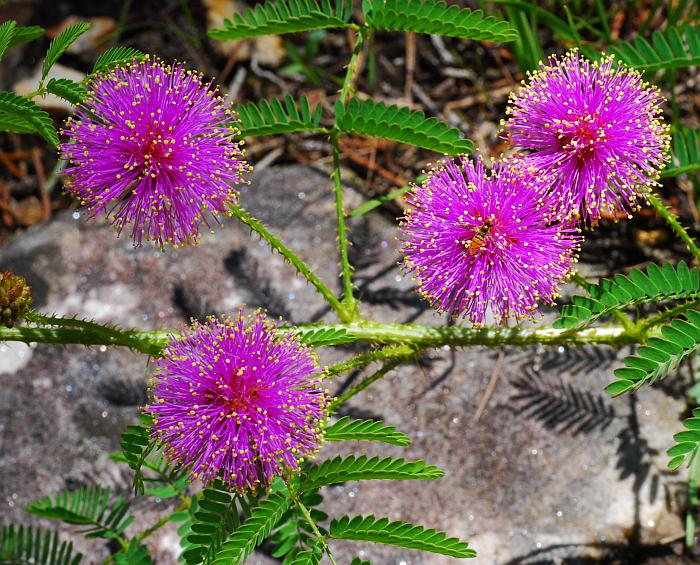Mimosa quadrivalvis L.
Sensitive Briar

Native
CC = 6
CW = 5
MOC = 71
© SRTurner
Mimosa quadrivalvis L.Sensitive Briar | |
 |
Native CC = 6 CW = 5 MOC = 71 |
© SRTurner |
|
Family - Fabaceae/Mimosoideae Habit - Perennial herbs, with a thickened, woody taproot, armed with prickles. Stem - Sprawling or clambering over other vegetation, to 3 m, finely ridged toward the base, strongly ribbed above the midpoint, glabrous, yellow to yellowish brown, armed with numerous short, downward-curved prickles, these sparser toward the base, yellow to yellowish brown.
Leaves - Alternate, twice pinnately compound. Petiole 2-5 cm long, armed with scattered to dense, short prickles similar to those of the stem, lacking glands. Stipules inconspicuous, 2-7 mm long, linear to hairlike. Leaf blades 6-12 cm long, with 3-8 pairs of pinnae, each with 8-16 pairs of leaflets. Leaflets 3-9 mm long, 2-4 mm wide, oblong, oblique at the base, short-tapered to a bluntly pointed or minute, abrupt, sharply pointed tip, with sparse, loosely ascending hairs along the margins.
Inflorescences - Spherical, headlike clusters, axillary, each 2.0-2.5 cm in diameter (including the stamens), with numerous (usually more than 75) short-stalked flowers (sometimes a few of the inner flowers staminate). Stalks 1.5-4.0 cm long at flowering, becoming elongated to 3-10 cm long at fruiting, armed with scattered to dense, downward-curved prickles similar to those of the stem.
Flowers - Calyces minute, to 0.2 mm long, cup-shaped to conical, fused nearly to the tip, with microscopic irregular lobes, glabrous. Corollas 2.5-3.5 mm long, lobed less than 1/2 the way to the base, usually pink to purplish pink (rarely pale cream-colored with pinkish-tinged lobes), the lobes rounded to sharply pointed at the tip. Stamens 8-12, the filaments 7-10 mm long, not fused at the base, pink or lavender pink.
Fruits - Fruits 3-9 cm long, 3-6 mm wide, narrowly oblong, tapered to a nearly sessile base, tapered to a slender beak at the tip, straight or slightly curved, often somewhat flattened but appearing more or less 4-sided, the margins more or less straight and somewhat thickened, the surfaces not constricted between the seeds, densely covered with curved prickles, otherwise glabrous, straw-colored to yellowish brown at maturity, dehiscent by 4 valvelike strips. Seeds 8-30, 3-4 mm long, oblong in outline, slightly flattened, dark brown, smooth, somewhat shiny, sometimes covered with a thin, lighter outer layer that becomes cracked and peeling at maturity.
Flowering - May - October. Habitat - Glades, upland prairies, savannas, openings of dry upland forests, fields, ditches, railroads, roadsides. Origin - Native to the U.S. Lookalikes - None when flowering. Other info. - This pretty species is found across much of Missouri, though appears to be absent in many northwestern and southeastern counties. It is not particularly common. Beyond Missouri its range comprises a broad band within the southern-central portion of the continental U.S. When in flower the plant is unmistakable from its pink "powder puff" inflorescences. The visible part of these consists of pink stamens, with yellow anthers sometimes visible at the ends. The other flower parts are relatively small and buried within the mass. Photographs taken off Highway 13, St. Clair County, MO., 7-7-00, and in Big Spring Park, Carter County, MO., 6-7-03 (DETenaglia); also at Shaw Nature Reserve, Franklin County, MO, 5-29-2007 and 6-3-2007, and at Drury-Mincy Conservation Area, Taney County, MO, 4-14-2012 and 5-1-2012 (SRTurner). |